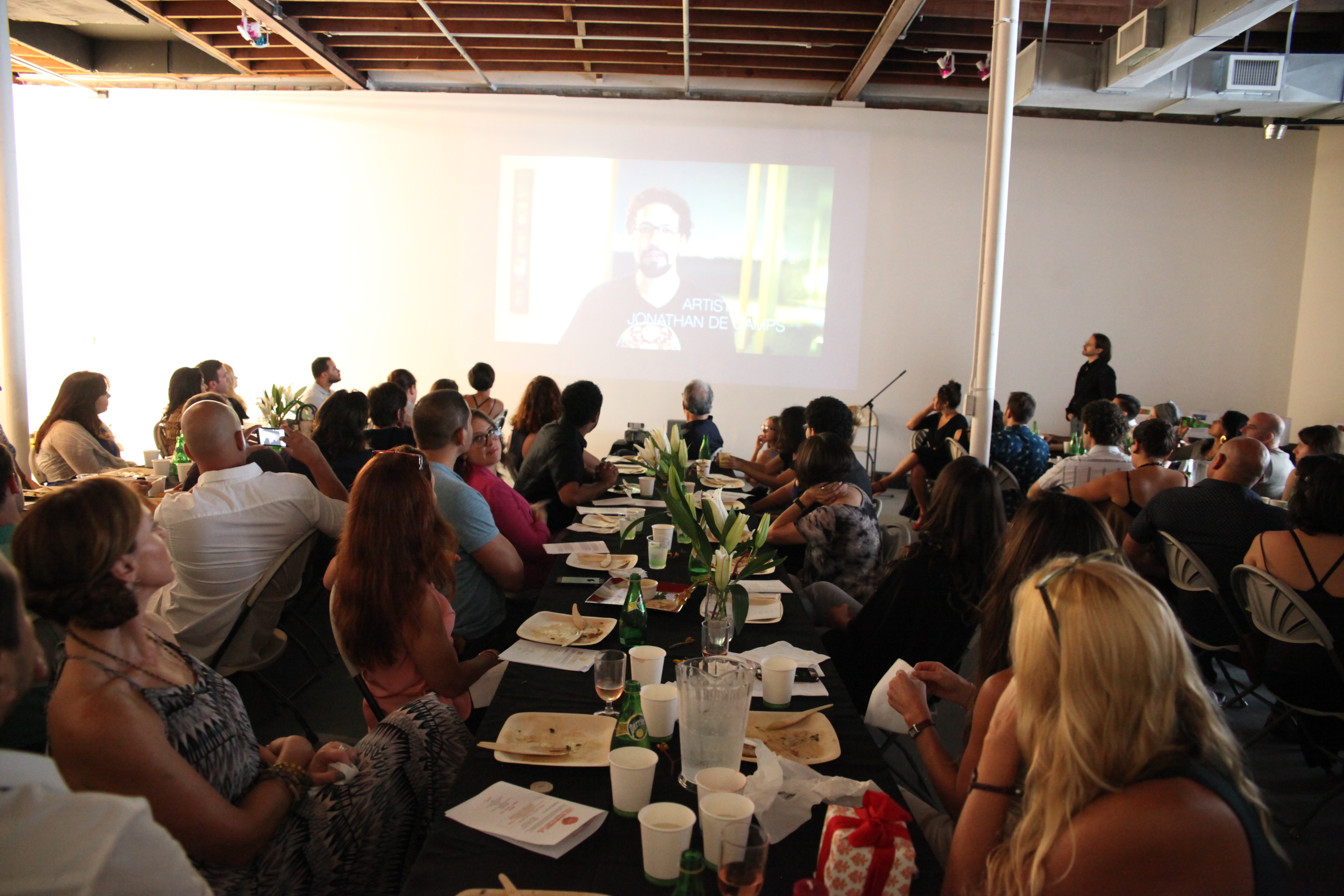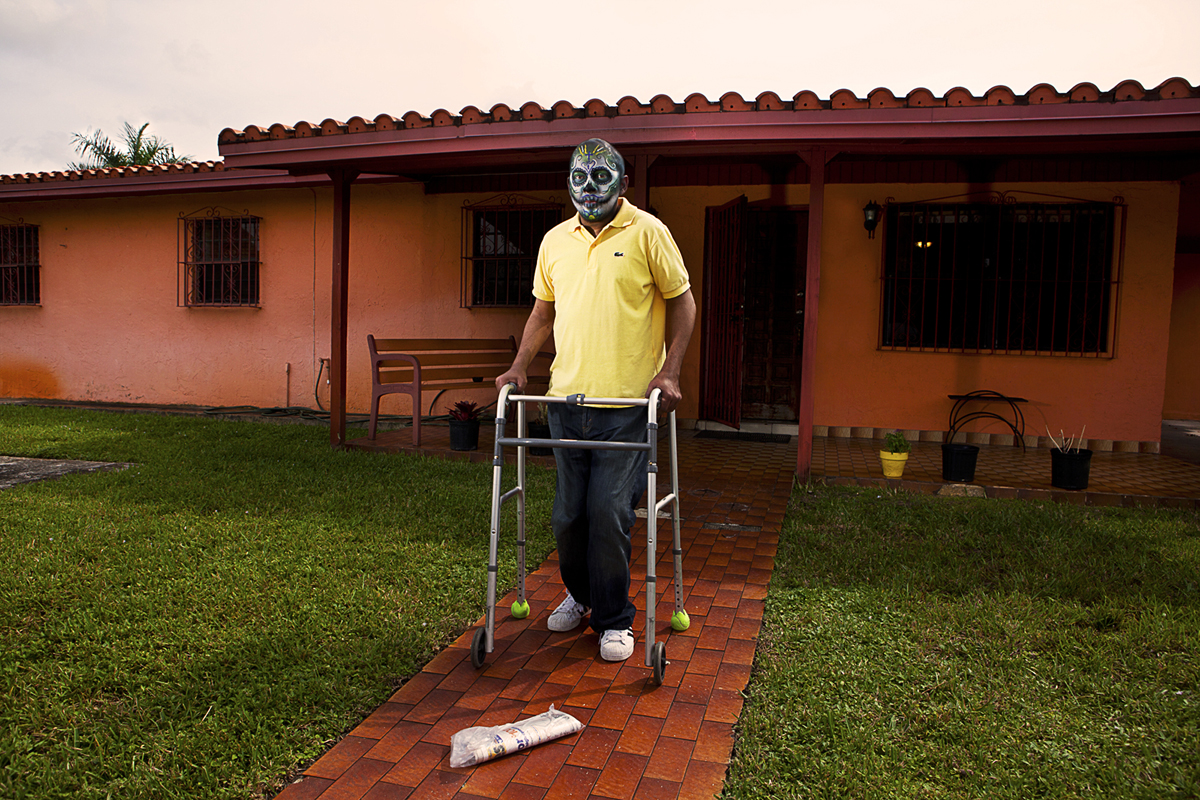
Arts micro-funding dinners are a feast for the Miami community
Photo: Getting ready for a FEAST Miami dinner at Locust Projects. Photo by Harold D. Ruiz.
Due to a technical problem, an earlier version of this post misquoted Rebecca Wakefield.
Almost everything about FEAST Miami is a community-building process. FEAST, which won a 2013 Knight Arts Challenge grant, revolves around home-cooked vegan food and dinner parties that help fund new art projects. The name, in fact, is an acronym for Funding Emerging Art with Sustainable Tactics.
How does this work? People buy tickets to a dinner at venues spread all across the county, ranging in cost from $30 to $60, and vote on an art project that has been submitted for consideration, usually choosing from about five proposals per dinner. Whoever wins receives the money that diners have contributed (via their ticket purchases) to further these projects.
The fourth of what will be 10 dinners was held on Saturday, Aug. 15, at the nonprofit Locust Projects gallery. Ingredients were donated by Whole Foods (another supporter of FEAST Miami) and volunteers helped out with the cooking, overseen by co-founder and chef Loren Pulitzer. Short videos and a program on the four art projects picked by a panel were shown and distributed during the Indian-themed meal.
According to FEAST’s other co-founder and ArtCenter/South Florida Artistic Director Susan Caraballo, the art projects can come from all disciplines, from literature and dance, to theater and visual arts. She and Loren encourage those who may not have had much exposure to the cultural world in the past, and who have ideas that are “innovative, feasible and impact the community” to apply. Caraballo stressed that they wanted the application process “to be as easy as possible.” Even in the case of applicants who don’t win, the artists may gain some marketing or promotional experience, she said, and their projects will be seen by a diverse audience.

A FEAST Miami dinner at Locust Projects. Photo by Harold D. Ruiz.
The first FEAST dinner was held at The Light Box at Goldman Warehouse in April 2014, and the first grantee, Amanda Keeley, was a relative newcomer to the Miami scene. Her mobile, pop-up bookstore, called EXILE Books, also won a 2014 Knight Arts Challenge grant. Other finalists at the inaugural event included audio and visual artist Juan Carlos Zaldivar and a micro-theater project.
This past February, Fairchild Tropical Botanic Garden was the venue. With 200 diners, it had the largest seating to date, allowing FEAST to charge less per seat compared to venues like Locust Projects that have more limited seating. The end goal is to raise between $1,000 to $3,000 for the winning project, Caraballo said. At Fairchild, the diners voted for Marie Whitman’s Eat Your Poem application, which she calls “poetry with a purpose.” Whitman proposed to send poets and writers into women’s shelters, both to read for entertainment and to encourage the women to create their own poetry and tell their stories. The end result, she hopes, will be a book of poetry written by shelter residents.
The winner at the second dinner, held at Wynwood’s Emerson Dorsch gallery, was Katie Wiegman, for her proposal to produce six to eight dance pieces along the boardwalk between South Beach and Mid Beach.
The emphasis of these pieces is on public works, community-building events or issues that relate to Miami.

A portrait from the “Ghosts in America” series by Jonathan De Camps.
On Aug. 15, the diners voted for Jonathan De Camps’ photography series, “Ghosts In America: Portraits of Undocumented Immigrants.” De Camps has been photographing average working-class people in Miami who happen to be undocumented, with their faces painted in the Dia de los Muertos Mexican mask tradition. The stunning photos show them in their homes, but without a face–our anonymous residents who don’t officially exist.
De Camps said this project is personal, as he was born in Puerto Rico and had to struggle to prove his Dominican roots while being raised in the DR (he now makes Miami home). “I have been an immigrant in one way or other for most of my life,” he said. “I have close friends who have been living in this country for most of their lifetimes and are still facing issues with their immigration status. They have been investing time and resources looking for ways of legalizing their status, but it has been difficult.”
Using the Mexican masks seemed to be an appropriate metaphor. “It’s a way in the Mexican tradition [to] represent their dead relatives–they represent ghosts. With the masks, I am representing undocumented immigrants becoming characters, ghosts workers,” De Camps added.

A portrait from the “Ghosts in America” series by Jonathan De Camps.
But while their faces are hidden, the intention of the project is to actually give them life, said co-producer Rebecca Wakefield. “The immigration debate itself is pretty frozen politically, and people tend to have an opinion that’s nearly religious in its certainty,” she said. “It’s all about Donald Trump or walls at the border or faceless masses of people filling in the cracks in our economy.
“This is a different approach, where you get an opportunity to really see immigrants in a different way. The portraits are shot inside their homes, so you get a little glimpse into their daily lives, which is where they sort of nurture their dreams and their hopes of eventually assimilating far enough into American society that they can drive a car without being worried about being pulled over and deported, or can go to college or go to the doctor. Things that citizens and legal residents take for granted.”
De Camps said the FEAST grant will “go to develop more portraits, with a variety of stories still pending to tell.”
FEAST organizer Caraballo said that so far, the dinners have been filled with almost entirely different crowds, some who know the artist projects and others who are interested in the theme. “At the last dinner, someone told me she mostly just wanted a vegan meal, and was intrigued by what else would happen,” she noted.
Up next: FEAST will be a brunch way down south in early November at the South Miami-Dade Cultural Arts Center, with the intention again of bringing in a new crowd. For every event, a new panel–drawn from a variety of disciplines, like the projects themselves–is convened to pick the finalists, to keep everything, like the food, fresh.
Overall, the biggest thrill for Caraballo is “being able to fund artists directly. That doesn’t happen often.”
For more information, visit FEAST Miami’s website.
Recent Content
-
Artsarticle ·
-
Artsarticle ·
-
Artsarticle ·
